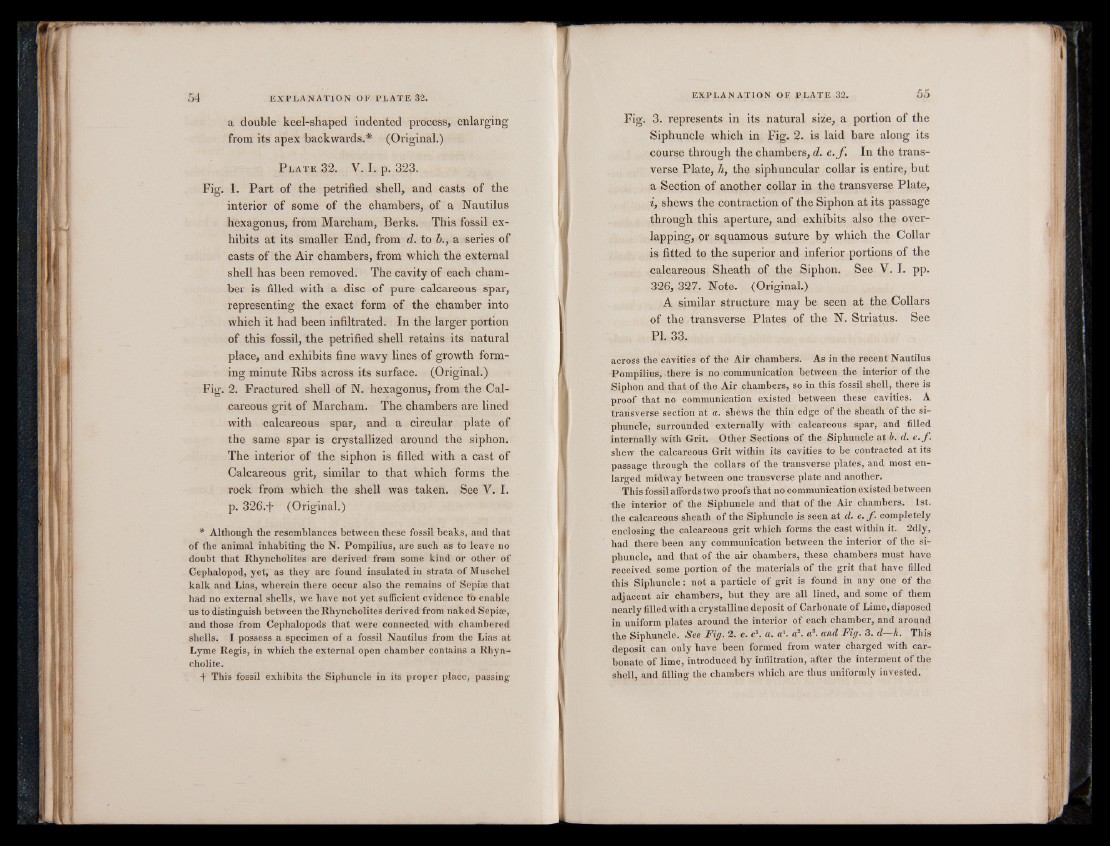
a double keel-shaped indented process, enlarging
from its apex backwards.* (Original.)
P late 32. V. I. p. 323.
Fig. 1. Part of the petrified shell, and casts of the
interior of some of the chambers, of a Nautilus
hexagonus, from Marcham, Berks. This fossil exhibits
at its smaller End, from d. to b., a series of
casts of the Air chambers, from which the external
shell has been, removed. The cavity of each chamber
is filled with a disc of pure calcareous spar,
representing the exact form of the chamber into
which it had been infiltrated. In the larger portion
of this fossil, the petrified shell retains its natural
place, and exhibits fine wavy lines of growth forming
minute Ribs across its surface. (Original.)
Fig. 2. Fractured shell of N. hexagonus, from the Calcareous
grit of Marcham. The chamber’s are lined
with calcareous spar, and a circular plate of
the same spar is crystallized around the siphon.
The interior of the siphon is filled with a cast of
Calcareous grit, similar to that which forms the
rock from which the shell was taken. See V. I.
p. 326.'f' (Original.)
* Although the resemblances between these fossil beaks, and that
of the animal inhabiting the N. Pompilius, are such as to leave no
doubt that Rhyncholites are derived from some kind or other of
Cephalopod, yet, as they are found insulated in strata of Muschel
kalk and Lias, wherein there occur also the remains of Sepise that
had no external shells, we have not yet sufficient evidence tb-enable
us to distinguish between the Rhyncholites derived from naked Sepia?,
and those from Cephalopods that were connected with chambered
shells. I possess a specimen of a fossil Nautilus from the Lias at
Lyme Regis, in which the external open chamber contains a Rhyn-
cholite.
f This fossil exhibits the Siphuncle in its proper place, passing
Fig. 3. represents in its natural size, a portion of the
Siphuncle which in Fig. 2. is laid bare along its
course through the chambers, d. e .f. In the transverse
Plate, h, the siphuncular collar is entire, but
a Section of another collar in the transverse Plate,
i, shews the contraction of the Siphon at its passage
through this aperture, and exhibits also the overlapping,
or squamous suture by which the Collar
is fitted to the superior and inferior portions of the
calcareous Sheath of the Siphon. See V. I. pp.
326, 327. Note. (Original.)
A similar structure may be seen at the Collars
of the transverse Plates of the N. Striatus. See
PI. 33.
across the cavities of the Air chambers. As in the recent Nautilus
Pompilius, -there is no communication between the interior of the
Siphon and that of the Air chambers, so in this fossil shell, there is
proof that no communication existed between these cavities. A
transverse section at a. shews the thin edge of the sheath of the siphuncle,
surrounded externally with calcareous spar, and filled
internally with Grit. Other Sections of the Siphuncle at b. d. e .f.
shew the calcareous Grit within its cavities to be contracted at its
passage through the collars of the transverse plates, and most enlarged
midway between one transverse plate and another.
This fossil affords two proofs that no communication existed between
the interior of the Siphuncle and that of the Air chambers. 1st.
the calcareous sheath of the Siphuncle is seen at d. e. f . completely
enclosing the calcareous grit which forms the cast within it. 2dly,
had there been any communication between the interior of the siphuncle,
and that of the air chambers, these chambers must have
received some portion of the materials of the grit that have filled
this Siphuncle: not a particle of grit is found in any one of the
adjacent air chambers, but they are all lined, and some of them
nearly filled with a crystalline deposit of Carbonate of Lime, disposed
in uniform plates around the interior of each chamber, and around
the Siphuncle. See Fig. 2. c. c*. a. a1, aa. # . and Fig. 3. d—k. This
deposit can only have been formed from water charged with carbonate
of lime, introduced by infiltration, after the interment of the
shell, and filling the chambers which are thus uniformly invested.